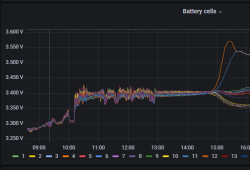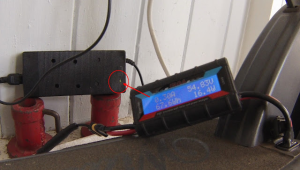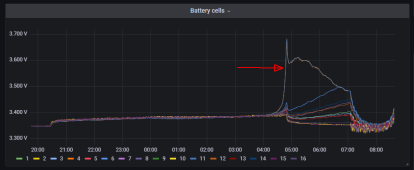The significant deviation in the cell voltage lines of the above two images is not encouraging.
You are using an out of date browser. It may not display this or other websites correctly.
You should upgrade or use an alternative browser.
You should upgrade or use an alternative browser.
Cell health in a 16s pack
- Thread starter Alexplose
- Start date
sunshine_eggo
Happy Breffast!
Wildly out of balance.
+1 this has to be the craziest cell graph that I have come across...Wildly out of balance.
I would not balance via the BMS but take the pack apart and put all the cells in parallel and charge them up to 3.55.
When you do this make sure the pos. and neg. leg of the charger are on the opposite ends of the pack to ensure the charge 'flows' through the pack effectively. Depending on the charger size it may take a while but make sure you do not over charge the pack.
I believe Will has a good video recapping the process I mentioned above.
Once all the cells are balanced then put them together and make sure the torque settings are similar to avoid a loose connection. From there you should have a good baseline to determine if you have some laggard cells.
+1 this has to be the craziest cell graph that I have come across...
I would not balance via the BMS but take the pack apart and put all the cells in parallel and charge them up to 3.55.
When you do this make sure the pos. and neg. leg of the charger are on the opposite ends of the pack to ensure the charge 'flows' through the pack effectively. Depending on the charger size it may take a while but make sure you do not over charge the pack.
I believe Will has a good video recapping the process I mentioned above.
Once all the cells are balanced then put them together and make sure the torque settings are similar to avoid a loose connection. From there you should have a good baseline to determine if you have some laggard cells.
Here is the today chart before I took the pack apart to top balance again in //, did as last time opposite pos. and neg. actually saying ~4A, and 3.421v at the legs.

It's almost like the cell balancing process that the BMS may be attempting is corrupted. It tries to balance but pushes more volts than it should. Like it's pulling volts out of all the cells but two and sending that voltage to the two cells.
TomC4306
Solar Obsessive
Raise your balance turn on voltage to 3.4. 3.3 is too low
pellicle
retired ex-professional dingbat
to @Alexplose I'm going to say (having read the whole thing at least passingly) what I think you need to do is individually charge each cell and monitor current and take each cell to the 3.65V level and measure the input current (I use a tool like a 150A in line which reports to me the voltage and the amps and other details in summary). Do this for each cell. Then do a discharge test at something like C or half C and again document that. This will (imo)Simple answer, #13 is always lowest v on discharge and always first to reach cutoff when charging… the cell is lowest capacity.
- clarify cell capacity
- provide useful data for a claim from the seller
Just my view.
NOTE: this is my 150A

Lacking a good measurement system I just put my GoPro on a gorilla pod and set it to take a still every 5 minutes ... then I just go through from the last image and can plot data from that ... of course the summary of Wh and Ah in (and of course turn it around and "out") is immediately helpful without referring to the "history data".
also, if not using a BMS make sure you don't go into over discharge or over charge!
Best Wishes
pellicle
retired ex-professional dingbat
this is a good theory and different BMS's have different capacity for a delta V between cells (especially passive type BMS).It's almost like the cell balancing process that the BMS may be attempting is corrupted. It tries to balance but pushes more volts than it should. Like it's pulling volts out of all the cells but two and sending that voltage to the two cells.
pellicle
retired ex-professional dingbat
Have you tried turning off the balance function or at least raise the trigger voltage to 3.55 or 3.6? It would be interesting to see if that is causing the issue (BMS). Having that many cells go haywire like that makes me think this is not a single or two cell issue but a BMS issue.
FYI -
Here is my graph for a 16 280ah cells. Notice at the low range (AM) the cells have a delta of .05 or so (bottom of the cell knees) I do not balance since this is 'normal' for my cells, once they start to charge they have a delta of 0 or .01, again no balance function is enabled. They will stay this way until the upper knee but by then I have a shut off charge on the mppt to stop charging the battery, I stick to a 20-80% capacity range for longevity. The green line is the overall pack voltage.

Sojourner1
Itinerant
If you "top balanced" your cells to 3.55 you didn't top balance you cells. Fully Top balance to 3.65 you won't hurt the cells if you're doing this properly.
The very first time you got your cells and you said you top balanced the was is 3.65 or 3.55?
The very first time you got your cells and you said you top balanced the was is 3.65 or 3.55?
@Alexplose Just be very careful going the last .1 volts. there is very little AH left and you'll reach 3.65 a lot faster than you expect... I know i overcharged a few cells when i first put my pack together.If you "top balanced" your cells to 3.55 you didn't top balance you cells. Fully Top balance to 3.65 you won't hurt the cells if you're doing this properly.
The very first time you got your cells and you said you top balanced the was is 3.65 or 3.55?
sunshine_eggo
Happy Breffast!
Is this top balanced when the voltage accross the pack is 3.654V, and the individual cells are about 3.650-1V, charger is still pushing some amps, I disconnected, will let rest and see the resting voltage.
"I disconnected" - assuming you mean disconnected from the charger.
Once you terminate charging, you need to disconnect them from being in parallel. If you leave them in parallel, they will all stay at the same voltage. Disconnecting them will allow you to see any outlier behavior.
Yes that's it, so now I need to take them apart and see which one is mis behaving."I disconnected" - assuming you mean disconnected from the charger.
Once you terminate charging, you need to disconnect them from being in parallel. If you leave them in parallel, they will all stay at the same voltage. Disconnecting them will allow you to see any outlier behavior.
I measured 3.642, 3.643 on all cells how many time before I can see something ?
Last edited:
sunshine_eggo
Happy Breffast!
Yes that's it, so now I need to take them apart and see which one is mis behaving.
I measured 3.642, 3.643 on all cells how many time before I can see something ?
Longer the better. At least 24 hours.
+1 day but i am not sold it is a cell that is the problem from reviewing your graphs & given a large number of cells are showing wide swings. my bet is a bad bms or bad bms setting or wire / connection issue.Yes that's it, so now I need to take them apart and see which one is mis behaving.
I measured 3.642, 3.643 on all cells how many time before I can see something ?
sunshine_eggo
Happy Breffast!
At this time the deviation is between 3.604 and 3.595, I'll let some more time to make sur, and will recrimp my bms wires
That's pretty decent.
Similar threads
- Replies
- 7
- Views
- 494
- Replies
- 4
- Views
- 698
- Replies
- 10
- Views
- 574



